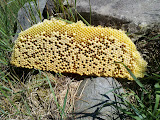On this warm day most of the hives had some bees fanning air in front of the entrances to the hives to improve ventilation. Green and Blue, being the largest hives also had the most fanners. My objective for the day was to apply powdered sugar dustings to most of the hives in my ongoing effort to keep the mites in check as well as to check on the general condition of each hive.
Orange: Last week I had added a (shallow) super with frames of drawn comb, and there were traces of nectar in some of the frames. I dusted the top brood box and super since I didn't want to crack it open to check on the bottom brood box.
Purple: Last week I had added a (medium) super made of frames of undrawn com (i.e. just foundation). I could not see any sign of the bees starting to draw that foundation into honeycomb yet. I didn't make a note as to if I dusted or not.
I took photos of a drone frame in place and pulled out of the hive. This was an experiment. Done frames, i.e. frames that have foundation sized for the larger drone larvae, are added by some beekeepers to their hives so that drone brood will be raised there and the mites that preferentially seek out drone brood will crawl in with them to breed. The beekeeper can then easily pull that frame out when the drone brood are capped and dispose of the brood and the mites, generally by scrapping the frames on site or freezing them and then scrapping them off or putting them back into the hive for the bees to clean out. The downside of this is that its a bit of a hassle to freeze and scrape them (and also rather gross). Bill Mares last year had given away many of his green plastic drone as he had switched over to using regular frames in which he had placed a starter strip of comb. The theory being that the bees would draw out their own comb underneath the starter strips and will almost always draw out drone comb as most hives with foundation are (in the bees' minds) woefully short places to build drone cells. The beekeeper can then just pull the frame when the drone cells are capped and cut out comb, and then insert the frame back into the hive. As can be seen in the picture, the gals have drawn out the starter strip with cells in which they have loaded with honey and capped, but below they have built the larger drone frames and in which there are little future drones developing.... unless I get to them first! They might be capped next week and I will remove them then.
Green: Last week I had added a (shallow) super with frames of undrawn comb and the gals had started drawing it out from the front of the hive backwards. The front of the hive is where this particular hive has both an upper entrance in the inner cover and additional holes drilled into the front of the super. I had drilled them to allow additional bee traffic (since this hive insisted on using its narrow upper entrance to the exclusion of the wide bottom entrance) and additional ventilation (the idea being that during the heat of summer, better ventilation will mean fewer bees having to ventilate the hive to keep it cool and to cure the nectar into honey). I did not make a note as to if I dusted it or not.
Swarm: The queen had made herself at home and there was a frame of capped brood, it some degree of a 'shot gun' scattering of empty cells indicative of non-perfect egg laying or some other problem, but probably not to a dangerous level. There was also a frame of honey (not sure if new or if I had given it to them when I moved them in) so they do have some reserves.
Blue: The medium super on top of blue was halfway drawn out. There also seemed to be a large number of young bees (paler in color, fuzzier than older bees). I did not note down if I dusted.
As I discussed with Purple, this hive had a starter strip drone frame in it. However, this frame was mostly capped and I did cut out the drone cells with my hive tool. It was a pretty easy procedure. I noticed that there were many cells in which I could see the dark mites squirming around inside. The cut out comb was then tossed into the chicken yard where, after some initially dubious pecks, the ladies had a bee larvae feast.
Red and Yellow: I didn't make any notes for these hives though I believe Red was noticeable in that the frames in the top brood box had not been drawn out at all.






No comments:
Post a Comment